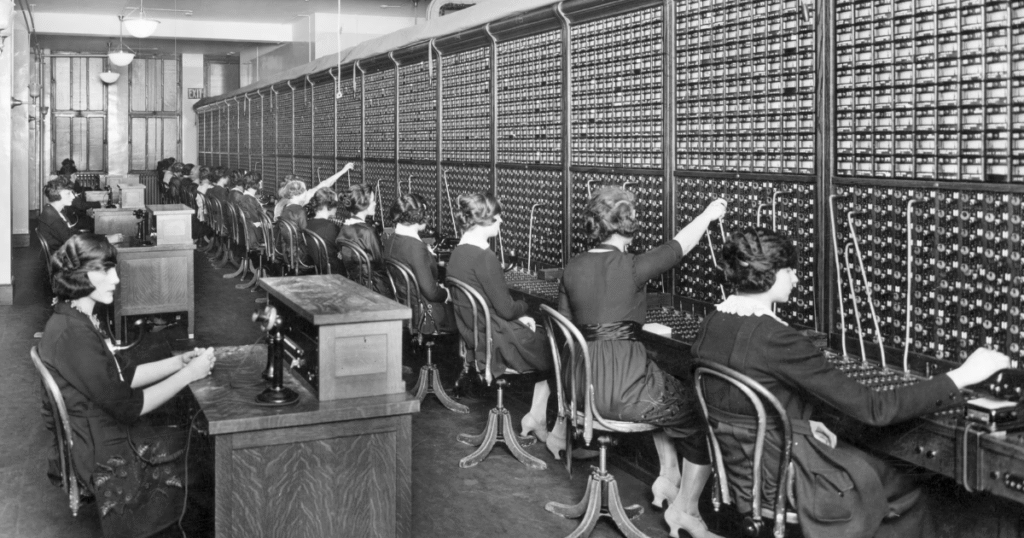
As America surged into the Jazz Age, another revolution was quietly unfolding — the mechanical whir of lathes, switchboards, and soldering irons powering the rise of telecommunications. In the mid-1920s, Boston and New York stood at the center of a technological transformation that would change how people connected across continents.
Though the modern smartphone was still decades away, the groundwork for global communication was being laid in smoky workshops and high-rise offices along the East Coast.
Where It All Began: Boston’s Role in the Birth of the Telephone
Boston’s ties to telecommunications reach back to its very roots. The original Bell Telephone Company, founded in the 1870s by Alexander Graham Bell and Gardiner Greene Hubbard, began right here.
By 1925, Bell’s vision had grown into the American Telephone & Telegraph Company (AT&T) — a sprawling corporate empire. Boston had shifted from hands-on production to corporate management, yet it remained the symbolic and strategic heart of the industry.
Meanwhile, the heavy lifting of manufacturing had moved to AT&T’s industrial arm, Western Electric. Its factories built everything from switchboards to signal relays — the backbone of early communication. Boston, though less industrial by then, remained the birthplace of an idea that changed the world.
New York Steps In: The Nation’s Industrial Nerve Center
If Boston was the birthplace, New York became the engine. The New York Telephone Company — another Bell System branch — ran a vast network serving millions of homes and offices across Manhattan and beyond.
At 463 West Street, Western Electric operated one of the nation’s most advanced telecom factories, later becoming Bell Telephone Laboratories — a name synonymous with invention. Here, engineers perfected the transcontinental phone line and developed early sound-recording technology.
On January 26, 1926, Bell Labs hosted one of the first public television demonstrations — proof that communication’s future was already taking shape. Nearby, 125 Greenwich Street housed a ten-story Western Electric plant from the 1880s — a vital piece of New York’s industrial legacy that still echoes through its skyline.
Inside the Workshops: The Human Hands That Built the Network

The 1920s factory floor was a place of craftsmanship, not automation. Skilled manual machinists shaped copper, brass, and steel into precision parts that carried the world’s voices.
Lathes, drill presses, and milling machines filled the air with rhythmic noise, while workers measured each part with micrometers and calipers — accuracy down to a thousandth of an inch.
These machinists often worked beside electromechanical technicians, the bridge between mechanical systems and electrical innovation.
“It was hard to find a good electromechanical technician even then,” a Bell engineer once remarked. “They needed both a steady hand and a sharp mind — part electrician, part mechanic, and part inventor.”
Building Technology Without Rare Earths
Unlike today’s electronics, early telephones didn’t rely on rare earth materials. They were built from iron, copper, carbon, and brass — durable, accessible, and affordable.
Receivers used thin iron diaphragms and permanent magnets, while transmitters relied on Edison’s carbon microphone design. Every part was handcrafted through painstaking manual labor.
This simplicity made mass production possible. Companies like Western Electric and Allen D. Cardwell Manufacturing Corporation scaled up without compromising quality — proof that innovation often thrives on practicality.
The Factories That Time Forgot — But Not Completely
Some of the buildings where this telecom revolution began still stand today, reminders of a time when communication was forged in steel and sweat.
| Building | City | Original Function | Current Role / Significance |
| Verizon Building (Barclay-Vesey) | New York | New York Telephone Co. HQ | Art Deco landmark; partly residential, retains telecom infrastructure |
| 195 Broadway | New York | AT&T Headquarters | Historic building; site of the first transatlantic call |
| 463 West Street (Bell Labs) | New York | Western Electric / Bell Labs Factory | Preserved, mixed-use space; birthplace of early telecom R&D |
| New England Telephone Sites | Boston | Regional exchanges / offices | Converted into offices/studios; architecture still reflects industrial roots |
The People Behind the Progress
Every connection — every hum of a dial tone — began with the steady hands of the experienced manual machinists, technicians, and engineers who built and maintained the system.
They were not just workers but inventors, shaping an era that linked homes, cities, and continents. Their patience and precision built the foundation for a connected world.
A Legacy That Still Rings True
The 1920s marked the beginning of a century-long evolution in communication. From switchboards to satellites, every leap forward can be traced to the work done in those Boston and New York workshops.
Today, as voices travel instantly through fiber-optic lines and digital networks, they carry with them a piece of that past — a reminder that every revolution begins with human hands, vision, and craftsmanship.

